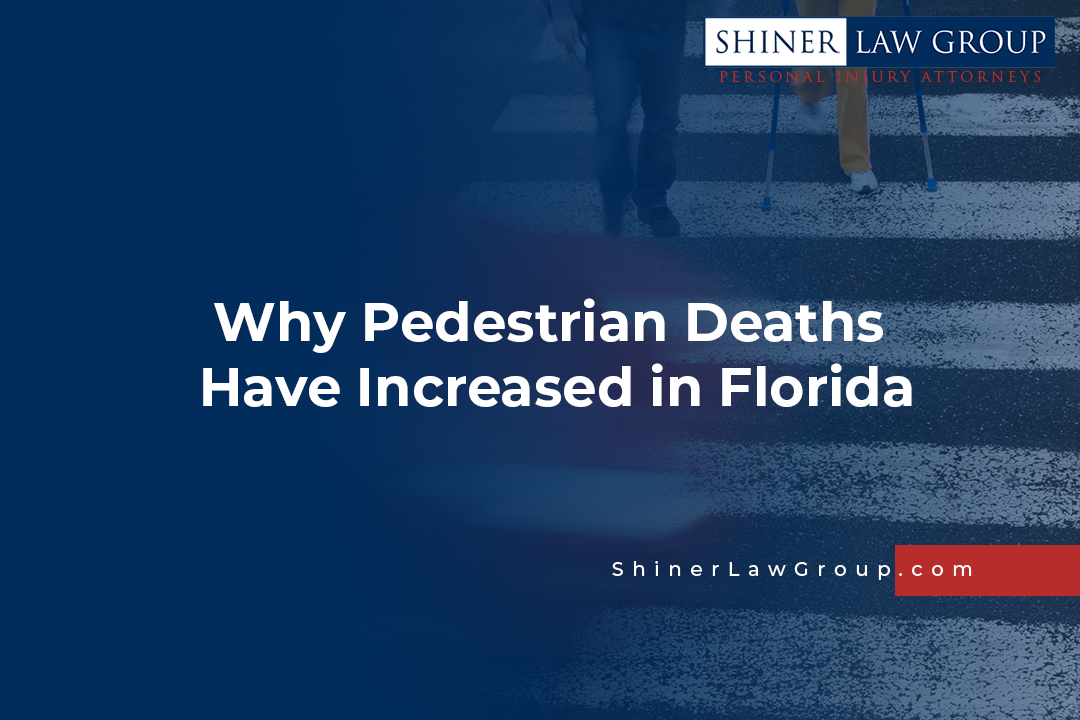When most people think of Florida, they are reminded of the beautiful theme parks and the crystal-clear waters right next to the sandy beaches. However, this beautiful locale is sadly ranked as the worst state for pedestrian safety according to a report by Smart Growth America.
It recorded 5433 deaths between 2008-2017 alone, with an average death rate of 2.73 pedestrians per 100000 people. The 5433 deaths were a troubling 11% of the 49340 pedestrians who lost their lives due to accidents in the whole United States.
The report also ranked Miami-Ft. Lauderdale as the 14th most dangerous city for pedestrians as it had 1549 pedestrian deaths in the same time gap. The pedestrian danger index for the city now sits at 153.5, which is quite shocking given that the PDI for the whole nation is 55.3.
A report from CBS Miami also showed that Miami’s pedestrian death rate went up by 35% in those ten years. In fact, South Florida’s I-95 was ranked the deadliest stretch of road in the North-South highway. There’s no surprise there, given all the congestion on the thin express lanes.
Other pedestrian accidents also occur on crosswalks, sidewalks, and streets. The accidents themselves are usually caused by trucks, motorcycles, scooters, and yes, even golf carts. This begs the question, why are pedestrian death rates up by 35%?

Table Of Contents
1. Poor Road Designs
Most cities in Florida aren’t built to accommodate pedestrians. The roads were designed to make travel easier for motor vehicles seeing as the state is very spread out. Such a layout made motor vehicles the preferred transit mode.
This means that the roads were designed to be very wide, and little regard was given to sidewalks, crosswalks, and bike lanes. Pedestrians nowadays have to cross multiple lanes and roads to access their destinations, even if there are no crosswalks in sight.
Jaywalking like this increases the risks of accidents occurring as some of those roads have fast-moving traffic that’s hard to navigate. With the increase in the number of pickup trucks and SUVs on the roads, a pedestrian now has a higher likelihood of dying if they get hit.
The intersections in the city also increase the likelihood of accidents happening. They give drivers the impression that they should move faster and make riskier moves to navigate the area properly. This comes from the fact the intersections weren’t designed to handle the huge volumes of traffic that they do nowadays.
A simple solution would be to get traffic to slow down so drivers can have more time to make decisions, and their vehicles should be directed through diamond interchanges instead of the classic four-way crossing.
2. Lax Traffic Enforcement and Insurance Laws
Statistics show that traffic accidents went up after a decline in the issuance of traffic tickets. Police departments in areas like Miami-Dade, Palm Beach, and Broward issued over half a million fewer tickets for road violations between 2012-2017. In that same period, the number of accidents rose by 33000 cases.
A few law officers claimed that the tickets had been reduced due to staffing shortages, and they had started relying more on written warnings and educational options to encourage good road practices. Did it work? Sadly, no.
As for the insurance laws, it isn’t a requirement for drivers to carry any liability insurance, so most accidents turn into a hit and run due to fear of lawsuits. This ultimately results in increased passenger deaths because the victims receive late medical help once they’re left to fend for themselves.
3. Pedestrian Vulnerability
Pedestrians have no airbags or protective gear that’s designed to help in case of an accident. The U.S Center for Disease Control and Prevention reported that pedestrians were twice as likely to die in an accident than if they were in a motor vehicle.
Therefore, as much as pedestrians have the right to be on public streets and highways, it is their duty to exercise caution and protect themselves whenever they see oncoming automobiles, just to be safe. It is a reciprocal duty that applies both to the pedestrian and the oncoming driver.
4. Over Speeding
A study by the AAA Foundation for traffic safety found that the average death risk for a pedestrian is 10% if the impact speed is 23mph, 50% if it’s 42mph, and 90% if it’s 58 mph.
The Florida Statute 316.183 banned traveling at unlawful speeds, which are speeds that are unreasonable depending on the current conditions. While most drivers took the speed limit into account when driving, they failed to consider other conditions like the weather, the type of street, traffic congestion, and/or flow. Such additional factors called for lesser speeds to avoid certain accidents.
5. Distracted Driving
Distracted driving has shot up in recent years because our brains are now required to process more and more information in our evolving world. Distracted driving falls under three main categories.
- Manual – Here, the driver doesn’t keep his hands on the steering wheel. This is most likely courtesy of the huge donut and coffee they bought at a drive-in.
- Visual – The driver’s eyes aren’t on the road in this scenario. Maybe they’re trying to keep the rampant kids in the backseat under control.
- Cognitive – The driver’s mind is not on the task at hand. They’re probably thinking of how they can’t wait to unwind once they get home.
It’s the small things that cause accidents on the roads. Texting while driving is also a major distraction that combines all three categories into one, essentially causing all hell to break loose. Now that over 75% of Americans have smartphones, it’s become a disturbing norm for road users to drive while texting/talking on their phones.
According to a study, talking on a cell while driving quadruples the chances that a driver will get in an accident that day.
6. Reckless Driving
Some drivers do not give proper attention to pedestrians simply because the said pedestrians are walking on their turf. Even those who operate in sensitive and congested areas don’t always look out for surprises like small kids suddenly darting out into the road. It is a motorist’s duty to be cautious and to slow down below the limit if it optimizes pedestrians’ safety.
In places where pedestrians majorly use streets and street crossings, motorists should be very vigilant not to breach the rights of pedestrians in the vicinity.
Drunk driving also falls under this category. It’s a no-brainer that driving under the influence reduces the driver’s reaction times and results in impaired judgment. Drunk drivers often run higher risks of veering off the road or driving past red lights without giving it a second thought.
Who is Liable for Pedestrian Accidents?
The damage that results from these accidents is compensated based on the degree of fault of all the parties involved. When a pedestrian is injured because of someone else’s negligence, they are entitled to seek compensation for the injuries caused.
However, it’s important to note that if a pedestrian shares the blame for causing the accident, they aren’t stopped from seeking compensation according to Section 768.81 of the Florida Statutes.
If you are a victim, then you may qualify to be compensated by:
- PIP (Personal Injury Protection) benefits: You may receive up to $10K and above from your auto insurance policy to cover PIP benefits. Those with no auto policy usually get PIP benefits from the insurer of the driver in question.
- UM/UIM benefits – These apply if the driver doesn’t have insurance or their insurance doesn’t allow you to get additional benefits. They also apply if the driver fled after the accident, where you’ll now seek the benefits from your auto insurance company.
- Claiming for additional damages – This usually applies if the damages exceed the PIP benefits available, and if you can prove that the driver was negligent.
To successfully prove negligence was involved, it must be established that a duty owed to you was breached, and were it not for that breach, you wouldn’t have been injured.
What Type of Injuries Can You Be Compensated for?
Pedestrian accidents have the power to cause severe damage ranging from:
- Internal injuries
- Nerve damage
- Spinal injuries
- Fractures and sprains
- Brain injury
- Death, etc.
Such damages warrant compensation for:
- Loss of earning capacity due to injuries sustained
- Loss of source of income
- Medical bills and expenses
- Rehabilitation services
- Mental and emotional distress
- Pain and suffering
Who Will Help You Get Compensated?
As much as you need to focus on your recovery after a pedestrian accident, you’ll still be required to seek compensation for damages. This is because the longer you delay, the more likely it’s going to become for witnesses to forget or change their minds about testifying. The damage will also be harder to assess as time goes by.
So how do you balance the two? Easy. A pedestrian accident attorney can act as your advocate so that you get the compensation you deserve without overexerting yourself. They will gather all available records for you to use in your case, from the police report to the hospital records.
You will thus get the best compensation available, even at such a time of weakness. Remember, even if an insurance company contacts you directly to settle the issue, it is highly likely that they want you to settle for less.
To ensure you reap maximum benefits, contact us at Shiner Law Group. We are personal injury law experts based in Florida. We take pride in representing those who incur losses due to someone else’s negligence and passionately fight for their claims so they get the compensation they deserve.
Our consultations are 100% free. We look forward to helping you navigate this tricky process!

